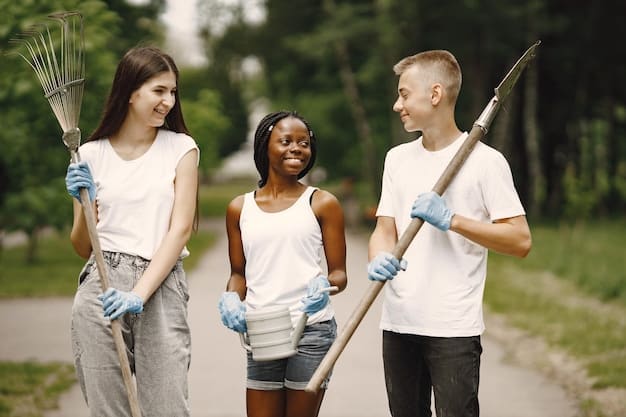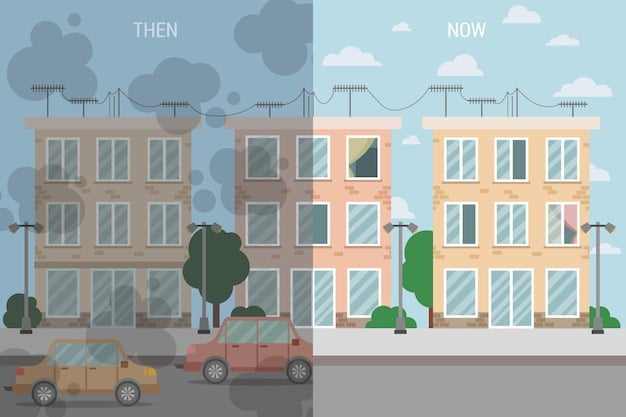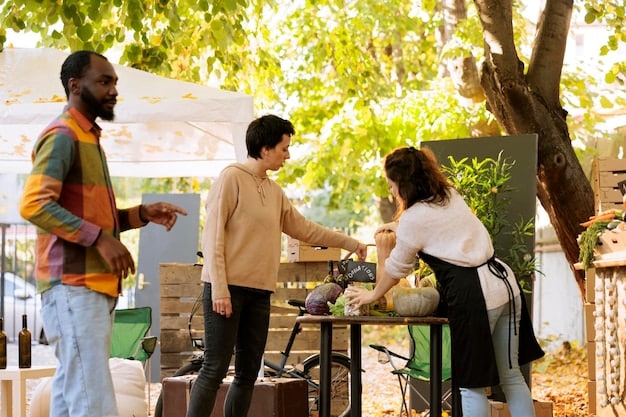Kindness Multiplier: Your Guide to a Neighborhood Cleanup

Kindness Multiplier in action, organizing a neighborhood cleanup not only beautifies the environment but also fosters community spirit and inspires others to engage in similar acts of kindness, promoting a ripple effect of goodwill and civic responsibility.
Want to create a positive impact in your community? Discover the kindness multiplier by organizing a neighborhood cleanup—a simple act that inspires widespread goodwill and participation.
Understanding the Kindness Multiplier Effect
The concept of a kindness multiplier suggests that a single act of kindness can generate a cascading effect, inspiring more people to perform acts of goodwill. Understanding this principle can motivate you to initiate positive change in your community.
Organizing a neighborhood cleanup is a tangible example of this concept in action. It transforms a physical space and demonstrates community commitment, encouraging others to participate and even instigate their own acts of kindness.
The Psychology Behind It
Psychologists have found that witnessing acts of kindness triggers a release of oxytocin, often referred to as the “love hormone.” This hormone promotes feelings of connection and empathy, making individuals more likely to reciprocate the kind behavior they have observed. This phenomenon helps explain why a small act, like a neighborhood cleanup, can have a far-reaching impact.
Sociological Implications
From a sociological perspective, community-led initiatives like cleanups foster social cohesion. They provide a platform for residents to interact, collaborate, and develop a sense of shared responsibility for their environment. This collective effort can strengthen community bonds and create a more supportive and engaged neighborhood.

Ultimately, the kindness multiplier extends beyond the immediate cleanup. It lays the groundwork for future community projects, creating a culture of proactive engagement and mutual support. When residents see the positive outcomes of collaborative efforts, they are more likely to invest their time and energy in similar initiatives.
In conclusion, recognizing the kindness multiplier effect empowers you to appreciate the tremendous potential of seemingly simple actions. By organizing a neighborhood cleanup, you set in motion a chain reaction of kindness, building a more connected and caring community.
Planning Your Neighborhood Cleanup: First Steps
Organizing a successful neighborhood cleanup requires careful planning and coordination. The first steps involve identifying key areas, securing necessary resources, and establishing a clear plan of action. These initial efforts are critical for ensuring that the cleanup is both effective and well-attended.
To begin, assess the neighborhood to pinpoint areas that would benefit most from a cleanup. Prioritize locations with high visibility or those frequented by residents. Next, gather a team of volunteers and assign roles, such as publicity, logistics, and safety coordination.
Assessing Problem Areas
Before diving into the cleanup itself, conduct a thorough assessment of your neighborhood. Identify areas that are prone to litter, such as parks, sidewalks, and vacant lots. Pay attention to the types of trash commonly found in these areas, as this will inform the supplies you need to gather.
Recruiting Volunteers
A successful cleanup hinges on the participation of enthusiastic volunteers. Start by reaching out to neighbors, community organizations, and local schools. Utilize social media, flyers, and word-of-mouth to spread the word and encourage sign-ups. Be sure to clearly communicate the date, time, and location of the cleanup, as well as any specific tasks volunteers will be responsible for.
- Contact local community leaders for endorsements and support.
- Partner with schools or youth groups for additional volunteers.
- Offer incentives, such as refreshments or small prizes, to boost participation.
Once you have a team of volunteers, it is essential to outline a clear action plan. This should include a timeline, designated areas for cleanup, and specific tasks for each volunteer group. Providing clear guidelines ensures that everyone understands their roles and responsibilities, minimizing confusion and maximizing efficiency.
By taking these crucial first steps, you establish a solid foundation for your neighborhood cleanup. Well-defined goals, a dedicated team, and a comprehensive plan of action set the stage for a successful and impactful event.
Securing Resources and Support
Effective neighborhood cleanups require more than just enthusiasm; they also need resources and support from various stakeholders. Obtaining necessary supplies, permits, and partnerships is crucial for ensuring a safe, efficient, and impactful event.
Start by creating a list of all the materials needed, such as trash bags, gloves, safety vests, and first-aid kits. Reach out to local businesses, community organizations, or government agencies that might be willing to donate these items. Additionally, explore opportunities for sponsorships that can help cover any additional expenses.
Reaching Out to Local Businesses
Local businesses are often eager to support community initiatives, especially those that enhance the neighborhood’s appearance and quality of life. Approach businesses with a clear proposal outlining the benefits of their involvement, such as positive publicity and community goodwill. Consider offering sponsorship packages that include logo placement on event materials and recognition during the cleanup.
Obtaining Necessary Permits and Permissions
Depending on the scale and location of your cleanup, you may need to obtain permits from local authorities. Check with your city or county’s environmental services department to determine if permits are required and what steps you need to take to obtain them. Additionally, seek permission from property owners before cleaning up private land.
Building Partnerships with Community Organizations
Partnering with established community organizations can provide valuable resources, expertise, and volunteer support. Reach out to groups such as neighborhood associations, environmental clubs, and faith-based organizations to explore opportunities for collaboration. These partnerships can amplify your outreach efforts and increase the impact of your cleanup.
- Identify potential partners with shared goals and values.
- Attend community meetings to network and build relationships.
- Collaborate on joint promotional efforts to maximize visibility.

Securing adequate resources and support is essential for the success of your neighborhood cleanup. By engaging local businesses, obtaining necessary permits, and building partnerships with community organizations, you can ensure that your event is well-equipped and supported.
In summary, a proactive approach to resource acquisition and partnership development sets the stage for a successful and impactful cleanup effort. These efforts not only ensure the logistical feasibility of the event but also foster a sense of community ownership and collaboration.
Promoting Your Cleanup and Maximizing Participation
Effective promotion is key to maximizing participation in your neighborhood cleanup. By utilizing various communication channels and engaging the community, you can raise awareness and encourage widespread involvement. A well-promoted cleanup not only garners more volunteers but also ensures a broader sense of community ownership.
Start by creating a comprehensive marketing plan that includes online, offline, and community outreach strategies. Use social media platforms, email newsletters, and local community boards to spread the word. Additionally, design eye-catching flyers and posters and distribute them in high-traffic areas, such as local businesses, community centers, and schools.
Leveraging Social Media
Social media is a powerful tool for reaching a wide audience and generating excitement about your cleanup. Create a dedicated event page on platforms like Facebook, Nextdoor, and Instagram, and share regular updates leading up to the event. Encourage volunteers to share their own posts and use relevant hashtags to amplify your message.
Engaging Local Media Outlets
Local newspapers, radio stations, and television channels are often interested in covering community events. Send a press release to local media outlets, highlighting the details of your cleanup and its potential impact on the neighborhood. Invite reporters to attend the event and capture the positive impact of community members working together.
Community Outreach Strategies
In addition to online promotion, engage in face-to-face community outreach to reach residents who may not be active online. Attend community meetings, set up information booths at local events, and partner with community leaders to spread the word. Personal interactions can be particularly effective in building trust and encouraging participation.
- Utilize eye-catching visuals in your promotional materials.
- Highlight the positive impact of the cleanup on the environment and community.
- Offer incentives for early sign-ups or volunteer recruitment.
A well-promoted cleanup not only attracts more volunteers but also fosters a sense of community pride and ownership. By strategically leveraging various communication channels, you can ensure that your event is widely known and well-attended.
By focusing on proactive promotion and community engagement, you can amplify the reach and impact of your cleanup. These efforts not only attract more volunteers but also cultivate a stronger sense of shared responsibility for the well-being of the neighborhood.
Conducting the Cleanup: Safety and Efficiency
Ensuring the safety of volunteers and the efficiency of the cleanup process is paramount. Clear guidelines, proper equipment, and effective coordination are essential for a successful and safe event.
Start by providing a comprehensive safety briefing to all volunteers before the cleanup begins. Cover topics such as proper lifting techniques, handling hazardous materials, and avoiding traffic. Equip volunteers with essential safety gear, including gloves, safety vests, and first-aid kits. Additionally, assign experienced volunteers to act as safety monitors to ensure that protocols are followed.
Safety Guidelines and Protocols
Establish clear safety guidelines and protocols to minimize the risk of accidents or injuries. Highlight the importance of wearing protective gear, avoiding contact with hazardous materials, and reporting any safety concerns to the designated safety monitors. Provide volunteers with a list of emergency contact numbers and a map of the cleanup area with designated first-aid stations.
Efficient Waste Collection and Disposal
Plan the waste collection and disposal process carefully to maximize efficiency and minimize environmental impact. Provide volunteers with sturdy trash bags and instruct them to separate recyclable materials from general waste. Arrange for regular trash pick-ups by local waste management services and ensure that all waste is disposed of in accordance with local regulations.
Coordination and Communication
Effective coordination and communication are vital for a smooth and efficient cleanup. Assign roles and responsibilities to volunteers, such as team leaders, supply coordinators, and safety monitors. Establish a central communication point where volunteers can report issues, ask questions, and receive updates. Use radios or mobile devices to maintain constant communication between team leaders and the event coordinator.
- Designate specific areas for different cleanup teams.
- Provide clear instructions on how to handle different types of waste.
- Encourage volunteers to take regular breaks and stay hydrated.
By prioritizing safety and efficiency, you can ensure that your neighborhood cleanup is productive, safe, and enjoyable for all participants. Clear guidelines, proper equipment, and effective coordination are the cornerstones of a successful event.
In essence, a well-organized and executed cleanup not only achieves its immediate goal of beautifying the neighborhood but also promotes a culture of safety and teamwork. These efforts contribute to a positive and impactful experience for all involved.
Sustaining the Momentum: Post-Cleanup Activities
The conclusion of the cleanup is not the end of the effort but rather an opportunity to sustain the momentum and build upon the progress achieved. Post-cleanup activities, such as acknowledging volunteers, celebrating successes, and planning follow-up initiatives, are crucial for maintaining community engagement and fostering long-term positive change.
Start by expressing gratitude to all volunteers, sponsors, and supporters who contributed to the success of the cleanup. Send thank-you notes, post acknowledgments on social media, and consider hosting a small appreciation event to celebrate their efforts. Additionally, share the results of the cleanup with the community, highlighting the amount of trash collected, the areas cleaned, and the positive impact on the neighborhood.
Acknowledging Volunteers and Supporters
Recognizing the contributions of volunteers and supporters is essential for fostering a sense of appreciation and encouraging future involvement. Send personalized thank-you notes, feature volunteers on social media, and consider hosting a small appreciation event to celebrate their efforts. Publicly acknowledge sponsors and partners, highlighting their commitment to the community.
Sharing the Results and Impact
Share the results of the cleanup with the community, highlighting the tangible improvements achieved through the collective effort. Publish photos and videos of the cleanup on social media, send updates to local media outlets, and present the results at community meetings. Quantify the impact of the cleanup by reporting the amount of trash collected, the areas cleaned, and any other relevant metrics.
Planning Follow-Up Initiatives
Sustaining the momentum generated by the cleanup requires planning and implementing follow-up initiatives. Conduct regular neighborhood assessments to identify areas that need ongoing attention, organize additional cleanup events, and implement educational programs to promote waste reduction and responsible disposal practices. Consider establishing a neighborhood beautification committee to oversee ongoing community improvement efforts.
- Develop a system for tracking and reporting waste collection data.
- Create a calendar of future cleanup events and community improvement projects.
- Partner with local schools to implement environmental education programs.
By embracing these post-cleanup activities, you can solidify the gains of the initial effort and create a sustainable culture of community engagement and environmental stewardship.
Ultimately, post-cleanup initiatives transform a one-time event into a catalyst for ongoing positive change. By acknowledging contributions, sharing results, and planning for the future, you can ensure that the impact of the cleanup extends far beyond the immediate event.
| Key Point | Brief Description |
|---|---|
| 🤝 Planning | Assess areas, gather volunteers, and create a clear action plan for effective cleanup. |
| 💪 Resources | Secure supplies, permits, and support from local businesses and community groups. |
| 📣 Promotion | Use social media, local media, and community outreach to maximize participation. |
| 🌱 Sustaining | Acknowledge volunteers, share results, and plan follow-up initiatives. |
FAQ
▼
The kindness multiplier is the idea that one act of kindness can inspire others, creating a chain reaction of goodwill and positive actions within a community.
▼
Begin by assessing areas needing cleanup, gathering volunteers, and creating an action plan. Secure necessary resources and promote your event to maximize participation.
▼
Essential supplies include trash bags, gloves, safety vests, and first-aid kits. Consider reaching out to local businesses for donations or sponsorships to cover costs.
▼
Use social media, community boards, and local media outlets to spread the word. Also, create flyers and posters and distribute them in high-traffic areas to reach a wider audience.
▼
Acknowledge volunteers, share the event results, and plan follow-up initiatives to maintain community engagement. Consider establishing a beautification committee for ongoing projects.
Conclusion
Organizing a neighborhood cleanup is a powerful demonstration of the kindness multiplier effect, not only transforming physical spaces but also cultivating community spirit and inspiring future acts of goodwill. By following the steps outlined in this guide, you can create a truly impactful event that leaves a lasting positive legacy in your neighborhood.





